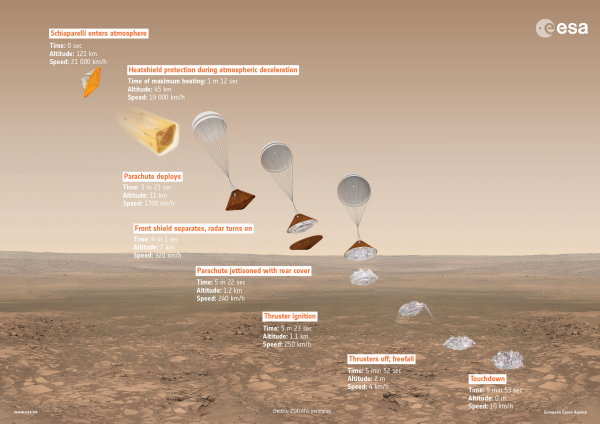The hazards of landing on Mars
Mars has been a source of wonder for many centuries, inspiring both scientific speculation and literary imagination.
Since the dawn of the Space Age, leading spacefaring nations have attempted to utilise modern technology to unveil the mysteries of Mars by surveying the planet from above and delivering robotic explorers onto its dusty terrain.
More than 40 missions have been despatched to the Red Planet since the early 1960s. Following the usual sequence of increasingly complex investigations, the early attempts to characterise Mars involved relatively straightforward, but short-lived, flybys. These were soon followed by orbiters, which carried ever more sophisticated instruments to map the entire planet and characterise its diverse landscapes.
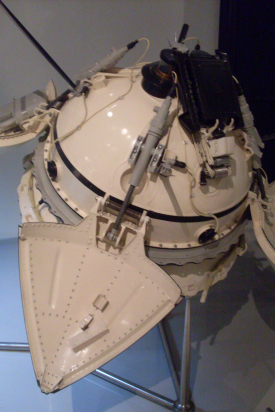 |
| Mockup (1:1) of Mars 3 lander at Memorial Museum of Cosmonautics, Moscow. By Armael (Own work) [CC0], via Wikimedia Commons |
The first attempt to deliver a probe into the atmosphere of Mars took place in November 1962, but the Soviet Union's spacecraft, designated Sputnik 24, failed to leave Earth orbit. Had it reached Mars, the probe would have hit the surface at high speed: its design had assumed that the atmosphere was thicker than was later found to be the case.
Later Soviet landing attempts in 1971 and 1973 also ended in failure (or only partial success): the Mars 2 lander crashed into the Martian surface, after it entered the atmosphere at too steep an angle, while the Mars 3 lander returned 20 s of data from the surface before expiring. Mars 6 returned some useful data from the lander's atmospheric entry and descent on arrival at Mars in 1974, but the signal was lost just before landing. The Mars 7 lander missed the planet by 1300 km due to electronics problems preventing it from acquiring the correct trajectory.
The first fully successful touchdowns on Mars had to wait until the arrival of the US Viking 1 lander on 20 July 1976, followed by the Viking 2 lander on 3 September. Since then, there have been five more successful landings on the Red Planet – all by US spacecraft - as well as a number of failed attempts. With the launch of ExoMars 2016, ESA sought to join NASA in becoming only the second space power to deliver a lander and complete a successful mission on the Martian surface. Unfortunately, it was not to be the case.
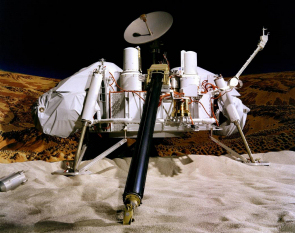 |
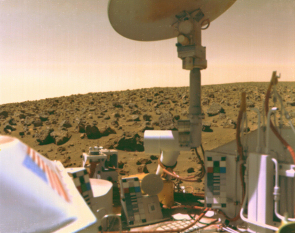 |
| Viking Lander model. Credit: NASA/JPL-Caltech/University of Arizona |
Viking 2 image from the surface. Credit: NASA/JPL |
Descent and landing
In order to minimise the likelihood of a catastrophic failure, space engineers spend a great deal of time working out how to ensure their high-tech vehicle completes a safe atmospheric entry and descent, culminating in a safe landing.
The first problem to be overcome is accurate navigation. Suitable launch windows occur every 26 months or so, when Earth and Mars are relatively close in their orbits. Once the Mars-bound spacecraft is en route, the journey typically lasts for about 6 months.
Assuming its trajectory intersects the orbit of Mars at the correct time, the spacecraft will be able to begin its atmospheric entry and descent phase. Most Mars landers – including the Schiaparelli entry and descent module of the ExoMars 2016 mission – make a high speed, ballistic entry into the atmosphere.
They are usually released from their carrier spacecraft in the final few days of the interplanetary journey. The exception was the Viking landers, which were carried into Martian orbit and only released from their orbiters after suitable landing sites were identified.
The angle of entry is important – too steep and the craft may overheat and burn up, too shallow and it may skip off the atmosphere, missing the planet altogether.
The entire atmospheric entry and descent control sequence is pre-programmed in the spacecraft's computer, since there is no time to send commands to it once the final phase of the flight begins. However, the sequence does not always go to plan. In the case of NASA's Mars Polar Lander, the retrorockets appear to have been commanded off prematurely, causing the spacecraft to crash land. An anomaly also resulted in the ExoMars Schiaparelli module turning off thrusters too soon, while it was still a few kilometres above the surface.
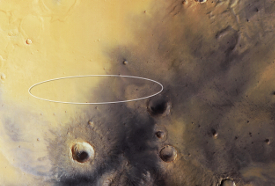 |
| ExoMars 2016 Schiaparelli landing site. Credit: IRSPS/TAS-I |
The descent trajectory is modified by variations in atmospheric density, turbulence and wind speed, as well as small uncertainties in the arrival trajectory, so the location of the landing site is fairly imprecise and typically defined by a large ellipse. In the case of Schiaparelli, the landing ellipse measures 100 km by 15 km. The possibility of regional or global dust storms arising prior to arrival can also affect the atmospheric conditions and lead to uncertainties in the descent trajectory.
Entering the upper atmosphere at a speed of almost 21 600 km/h (6 km/s), a spacecraft typically takes 6 to 7 minutes to reach the surface. First, it has to endure two to three minutes of extreme heating, caused by atmospheric friction. Protected by a heat shield, the craft is able to survive a temperature reaching several thousand degrees Celsius and buffeting by atmospheric shock waves.
The spacecraft decelerates rapidly, and by the time it has slowed to around 1700 km/h (0.47 km/s) at an altitude of around 10 km, it is able to deploy a supersonic parachute. A short time later, the speed has slowed sufficiently to allow the heat shield to be jettisoned.
On most missions, a radar is used to measure altitude (and sometimes speed relative to the surface) and decide when and how to command thrusters or retrorockets to bring the descent velocity down to a few metres per second; the thin Martian atmosphere makes it very difficult for this to be achieved with a parachute alone.
The procedure adopted during the final phase of the descent varies according to the size and complexity of the lander. The highly successful Viking landers, each weighing some 600 kg, fired three variable thrust engines during the final 1200 m of their descent. Schiaparelli was also designed to fire thrusters to slow its final descent, followed by a short free fall to the surface once the engines cut out.
 |
| Air bags for the Mars Pathfinder mission. Credit: NASA |
A smaller spacecraft, the 360 kg Mars Pathfinder, introduced a new descent system which involved lowering the lander at the end of a 20 m long cable (known as a "bridle"). About 10 s before touchdown, airbags inflated to form a protective 'ball' around the lander. Four seconds later, at an altitude of 98 m, three solid rockets, mounted in the backshell, fired to slow the descent, and about 2 s later the bridle was cut 21.5 m above the ground, releasing the lander. Pathfinder hit the ground at a speed of 14 m/s and bounced about 12 m into the air, rebounding at least another 15 times before coming to rest approximately 2.5 minutes after impact and about 1 km from the initial impact site.
A similar system of parachute, retrorockets and airbags was used for the larger Mars Exploration Rovers, which arrived on the surface in 2004. The British-led Beagle 2, also fitted with airbags but without any thrusters, appears to have landed but it was unable to communicate with home after some of its "petals" failed to open.
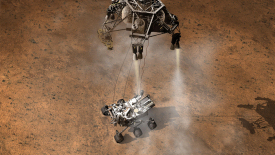 |
| Touchdown of the Curiosity rover, underneath the descent stage that acted as a sky crane. Credit: NASA/JPL-Caltech |
The largest Mars lander yet built is the Mars Science Laboratory (MSL), which delivered the Curiosity rover to Gale crater in August 2012. MSL weighed in at about 900 kg and measured three metres in length, so an airbag system was not viable and a new "sky crane" was developed. Although the mission team was unable to test the innovative technology before launch as an integrated system, the MSL operated perfectly.
The spacecraft was able to steer itself during entry into Mars' atmosphere with a series of S-curve manoeuvres similar to those used by astronauts piloting NASA space shuttles. During the three minutes before touchdown, the craft slowed its descent with a parachute, then fired retrorockets mounted around the rim of its upper stage. In the final seconds, the upper stage acted as a sky crane, lowering the upright rover on a tether in order to land on its wheels.
Sparse Atmosphere and Rugged Terrain
How are landing sites on Mars selected? In the 1960s and 1970s, detailed, accurate maps of Mars were not available, so the nature of the Martian surface was poorly understood. As a result, the Viking team decided to play safe by taking images of potential landing sites with the two orbiters before making a final selection of where to target their precious machines.
Since then, numerous orbiting spacecraft have mapped the Red Planet in great detail, so the emphasis is now as much on the scientific interest of the site as on the nature and relative safety of the terrain. Mars Pathfinder, for example, was targeted at an ancient river bed, while the Exploration Rovers and MSL headed for locations that were believed to have once supported surface water and potentially habitable environments.
However, a map of Martian landing sites shows that about half of the planet has so far been avoided. It is no coincidence that all successful landings on Mars have taken place in a region dominated by flat lowlands, rather than more rugged areas, such as the heavily cratered highlands found south of the equator. Although the near-equatorial and northern plains are often marked by small impact craters, boulders of various sizes and dusty dunes, the chances of damage on arrival are quite small.
Most of the landings have been at low latitudes, the sole exception to date being Phoenix, a stationary lander which survived for five months in the Martian Arctic before expiring as a result of the extreme cold and lack of sunlight.
Another factor that influences the choice of landing site is the thickness of the Martian atmosphere. On Earth, spacecraft can parachute or glide back through the dense blanket of air on completion of their orbital mission. However, the Martian atmosphere is 150 times thinner than on Earth, and the air pressure changes by 20% from season to season. The surface pressure is thickest over the deep canyons and thinnest above the giant volcanoes.
Not surprisingly, mission planners have opted to target their craft over the lowland areas where the greater depth and thickness of atmosphere enables atmospheric friction and parachutes to slow the spacecraft's descent to the greatest extent.
ESA's ExoMars missions are no exception. Schiaparelli landed on Meridiani Planum, a relatively smooth, flat region close to the Martian equator and fairly near the current location of NASA's Opportunity rover. Three sites near the equator are currently being investigated for the ExoMars 2020 mission, which will deliver ESA's first planetary rover.
Providing power
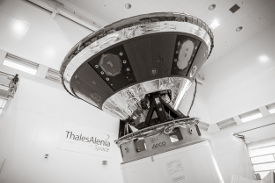 |
| Schiaparelli module. Credit: Thales Alenia Space/Imag[IN] |
Almost all of the landers and roving vehicles delivered to Mars since Pathfinder in 1997 have been powered by solar panels. Schiaparelli was unusual by carrying only non-rechargeable batteries, so its active life, had it made it intact to the surface, would have been limited to only a few Martian days. This is because its primary objective was to demonstrate entry, descent and landing technologies. The other exception is the nuclear-powered MSL, which is able to operate regardless of the amount of sunlight.
The success and duration of the solar-powered surface missions depends upon the availability of sunlight to illuminate the solar cells.
Since Mars has similar seasons and periods of daylight to Earth, the landers' power budgets have to be managed carefully so that they can survive the shorter winter days – another reason for landing near the equator. Mobile roving vehicles have the advantage of being able to park in a relatively sunny spot so that their batteries can be recharged.
A build up of dust deposits on the solar panels may also reduce the vehicle's electrical output – although occasional gusts of wind may sweep away much of the brownish coating. Although ExoMars 2020 will arrive outside the main dust storm season, the mission team is aware that the solar-powered lander and rover may occasionally have to cease operations due to dust darkening the sky.

